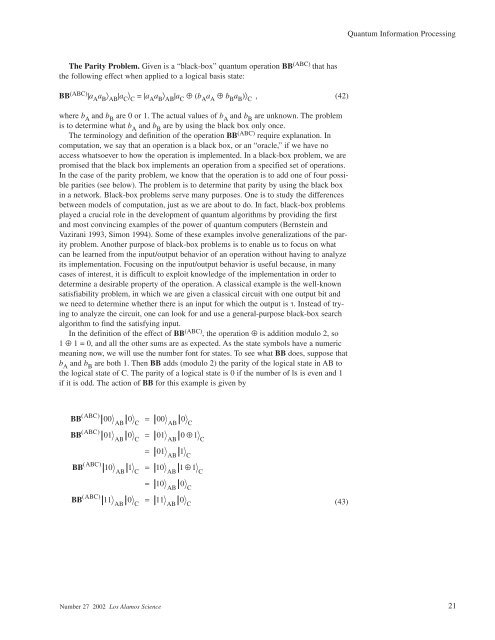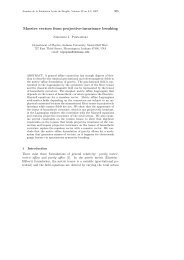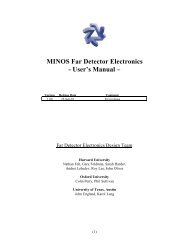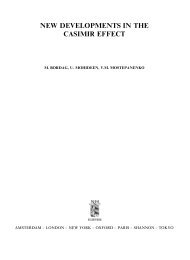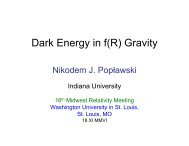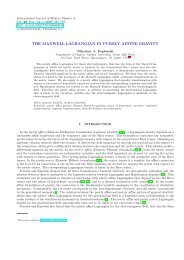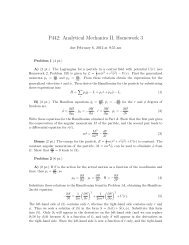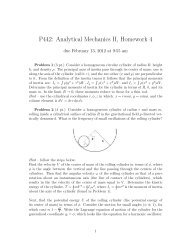Quantum Information Processing
Quantum Information Processing
Quantum Information Processing
Create successful ePaper yourself
Turn your PDF publications into a flip-book with our unique Google optimized e-Paper software.
The Parity Problem. Given is a “black-box” quantum operation BB (ABC) that has<br />
the following effect when applied to a logical basis state:<br />
BB (ABC) |a A a B 〉 AB |a C 〉 C = |a A a B 〉 ΑΒ |a C ⊕ (b A a A ⊕ b B a B )〉 C , (42)<br />
where b A and b B are 0 or 1. The actual values of b A and b B are unknown. The problem<br />
is to determine what b A and b B are by using the black box only once.<br />
The terminology and definition of the operation BB (ABC) require explanation. In<br />
computation, we say that an operation is a black box, or an “oracle,” if we have no<br />
access whatsoever to how the operation is implemented. In a black-box problem, we are<br />
promised that the black box implements an operation from a specified set of operations.<br />
In the case of the parity problem, we know that the operation is to add one of four possible<br />
parities (see below). The problem is to determine that parity by using the black box<br />
in a network. Black-box problems serve many purposes. One is to study the differences<br />
between models of computation, just as we are about to do. In fact, black-box problems<br />
played a crucial role in the development of quantum algorithms by providing the first<br />
and most convincing examples of the power of quantum computers (Bernstein and<br />
Vazirani 1993, Simon 1994). Some of these examples involve generalizations of the parity<br />
problem. Another purpose of black-box problems is to enable us to focus on what<br />
can be learned from the input/output behavior of an operation without having to analyze<br />
its implementation. Focusing on the input/output behavior is useful because, in many<br />
cases of interest, it is difficult to exploit knowledge of the implementation in order to<br />
determine a desirable property of the operation. A classical example is the well-known<br />
satisfiability problem, in which we are given a classical circuit with one output bit and<br />
we need to determine whether there is an input for which the output is . Instead of trying<br />
to analyze the circuit, one can look for and use a general-purpose black-box search<br />
algorithm to find the satisfying input.<br />
In the definition of the effect of BB (ABC) , the operation ⊕ is addition modulo 2, so<br />
1 ⊕ 1 = 0, and all the other sums are as expected. As the state symbols have a numeric<br />
meaning now, we will use the number font for states. To see what BB does, suppose that<br />
b A and b B are both 1. Then BB adds (modulo 2) the parity of the logical state in AB to<br />
the logical state of C. The parity of a logical state is 0 if the number of ls is even and 1<br />
if it is odd. The action of BB for this example is given by<br />
BB<br />
BB<br />
BB<br />
BB<br />
( ABC)<br />
( ABC)<br />
( ABC)<br />
( ABC)<br />
00 0 = 00 0<br />
AB C AB C<br />
01 0 = 01 0 ⊕1<br />
AB C AB C<br />
=<br />
01 1<br />
AB C<br />
10 1 = 10 1 ⊕1<br />
AB C AB C<br />
=<br />
10 0<br />
AB C<br />
11 0 = 11 0<br />
AB C AB C<br />
Number 27 2002 Los Alamos Science 21<br />
(43)<br />
<strong>Quantum</strong> <strong>Information</strong> <strong>Processing</strong>


